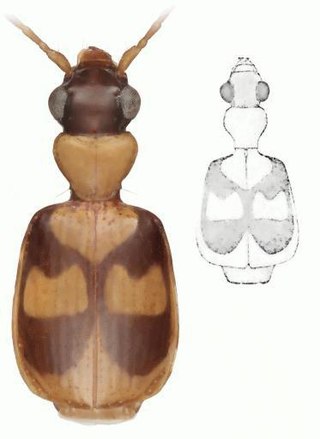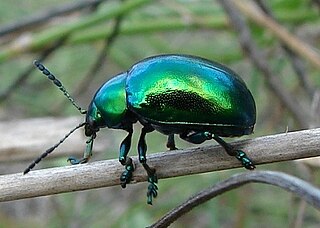
Oryzaephilus surinamensis, the sawtoothed grain beetle, is a beetle in the superfamily Cucujoidea. It is a common, worldwide pest of grain and grain products as well as chocolate, drugs, and tobacco. The species' binomial name, meaning "rice-lover from Suriname," was coined by Carl Linnaeus, who received specimens of the beetle from Surinam. It is also known as the malt beetle and may be referenced in the poem This Is The House That Jack Built in the line "....the rat that ate the malt that lay in the house that Jack built" the malt referenced may not be actual malted grain but a sawtoothed grain beetle.

Virola surinamensis, known commonly as baboonwood, ucuuba, ucuhuba and chalviande, is a species of flowering plant in the family Myristicaceae. It is found in Brazil, Costa Rica, Ecuador, French Guiana, Guyana, Panama, Peru, Suriname, and Venezuela. It has also been naturalized in the Caribbean. Its natural habitats are subtropical or tropical moist lowland forests, subtropical or tropical swamps, and heavily degraded former forest. Although the species is listed as threatened due to habitat loss by the IUCN, it is a common tree species found throughout Central and South America.

Aphyarctia is a monotypic moth genus in the family Erebidae. Its single species, Aphyarctia surinamensis, described by Walter Rothschild in 1911, is found in French Guiana, Suriname, Ecuador, and Bolivia.

Asklepia is a genus of beetle in the family Carabidae first described by Max Liebke in 1938.
Straneotia is a genus of beetles in the family Carabidae, containing the following species:
Thoasia rugifrons, the rough-headed pentagonal arboreal carabid, is a species of beetle in the family Carabidae. It is found in Colombia, Venezuela, and in the lowlands of French Guiana.

Trephionus is a genus of ground beetles in the family Carabidae. There are about 19 described species in Trephionus, found in Japan. Five of these were new species described in 2018.
Halocoryza is a genus of beetles in the family Carabidae, containing the following species:
Pyrausta surinamensis is a moth in the family Crambidae. It is found in Suriname.

Omophron nitidum, the shiny round sand beetle, is a species of ground beetle in the family Carabidae. It is found in North America within the United States, in areas such as Indiana, Minnesota, Nebraska, Alabama and Texas. Adults are nocturnal, spending their time in burrows and leaf litter during the day. The breeding of O. nitidum takes place from March to December.
Agra dable is a species of carabid beetle. The holotype was collected in Costa Rica and first described to science in 2002.
Thoasia is a genus of beetle in the family Carabidae. It was once classified as a monotypic genus with the species Thoasia rugifrons, however recently three new species were found.
Thoasia pterosmaragdos, the emerald-winged pentagonal arboreal carabid, is a species of beetle in the family Carabidae. It is found in French Guiana.
Thoasia manu, the Río Manú pentagonal arboreal carabid, is a species of beetle in the family Carabidae. It is found in Amazonian lowlands, Perú and Yasuní region of Ecuador.
Straneotia amazonica, the Amazon slim arboreal carabid, is a species of beetle in the family Carabidae. It is found in western Amazon Basin.
The Confusing slim arboreal carabid,, is a species of beetle in the family Carabidae. It is found in Amazonian lowlands in the Yasuní area of northeastern Ecuador.
Straneotia freyi, the Frey's slim arboreal carabid, is a species of beetle in the family Carabidae. It is found in Amazonian lowlands near Belém, Brazil.
Straneotia moi, the snake-head slim arboreal carabid, is a species of beetle in the family Carabidae. It is found in French Guiana.
Straneotia cylindroceps, the tube-headed slim arboreal carabid, is a species of beetle in the family Carabidae. It is found in Yasuní area of northeastern Ecuador.

Eumolpus robustus is a species of leaf beetle from North America. It has the most northern range of the members of the genus Eumolpus, spanning from Central America north to Mexico and Arizona.






